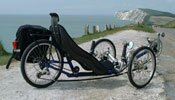

|
About Recumbents Why ride a Recumbent? Another benefit of the recumbent seating position is a more open chest and diaphragm that makes for easier breathing. You’ll be able to ride longer with less fatigue and arrive at your destination feeling refreshed. You’ll have a better view of the road and your surroundings. Recumbents are great for touring and day rides.What is a recumbent?!? The term “Recumbent” refers to the seating position and means: “lying down.” Or to be supine! RECUMBENT: re•cum•bent adj. Are they comfortable? How much do recumbents cost? How do I choose a style? Here are some considerations to help with your decision
For more information, see issues of RCN, articles at our website, and check out the alt.rec.bicycles.recumbent newsgroup and hpv mailing list (from www.ihpva.org). Are recumbents difficult to balance and ride? How do I start off on a recumbent? Ergonomics — Which configuration will work best for me? Basic user-friendly ergonomics include a moderate seat height of around 20 or so inches off the ground, with pedals mounted noticeably lower (a similar height to a diamond-frame bike). This design would place the rider in a fairly upright position which places much of the rider’s weight on their bottom, which for some riders, can make for recumbent butt. This position is similar to driving an automobile. As the pedal height is increased, the seat can be reclined more, thus taking some of the weight off the rider’s bottom. Often, however, raising the feet can cause foot and toe numbness, may require clipless pedals; it can also take a second or two longer to get your feet to the pedals or back to the ground. When the pedals are raised way up and the seat is reclined way back (what we describe as an extreme position), there can also be neck fatigue, as one has to lower one’s chin to neck fatigue, as one has to lower one’s chin to look straight ahead. This is usually found on high- performance and racing recumbents and may not be suitable for average riders. For new riders, the best place to start is a compact or LWB with low pedal height. If you’re an athlete or more advanced rider or if you have a special need, finding the optimum riding position and model for you may take some time and patience. Fit Notes — If you’re 5’6” to 6” tall you can ride¨ most any recumbent. If you’re shorter or taller than average, you should check out recumbents that come in multiple frame sizes. Shorter riders may want to check out LWB’s, trikes, and SWB’s with 16- inch front wheels. Models with full-size wheels may be too tall for you. Larger and/or taller riders might want to try LWB’s and longer SWB’s (those with wheelbases of 40 inches or more). Look for stiff, strong frames and low pedal heights with more moderate or open riding positions. Ask about weight limits, capacities, and warranties. Opt for fatter tires if possible (20- and 26-inch tires offer the most options). What are the different types of seats?
What are the types of recumbent steering? What kind of wheels do recumbents use? Do recumbents require special components? Mid-drives, two-chain drives, independent pedaling options, hydraulic brakes, and/or other proprietary parts can complicate your bike and make service and parts replacement more difficult, time consuming, and costly. We recommend that you keep a cache of spare parts for your specific bike in case of a problem. You should consider keeping a spare tubes, tires (one of each size), mid-drive cassette, suspension shock, etc. What about those long chains? Do I need suspension? One small wheel models achieving acceptable gearing (with a small drive wheel) is also a consideration. CLWB’s and LWB’s can best utilize rear suspension. SWB’s can best utilize front suspension (first) or full suspension. Are recumbents fast? Despite the aerodynamic advantage of most recumbents, they are often a bit slower than their upright counterparts in real world riding. The fastest recumbents are lowracers, highracers, faired SWB’s, and LWB OSS models with front fairings (though not necessarily in this order). Which will perform best for you will depend on which type fits your body type, riding style, locale and how much bike you can handle (or adapt to). Are recumbents twitchy handling? Are recumbents safe? All recumbent riders should use a rear-view mirror, as turning to look behind you is more difficult on a recumbent than on a diamond-frame bicycle. Riders should also use bicycle safety gear such as reflective clothing, a helmet, a horn, a safety flag, and lights when riding at night. How to you transport a recumbent? There are lightweight trailers that will accept bicycles. Having truck or van is also helpful, but not necessary. Your best recumbent transporting advice will come from your bike’s manufacturer or your local recumbent dealer. Where can I find more information? |
|